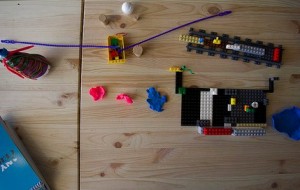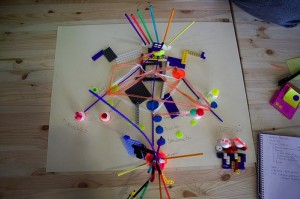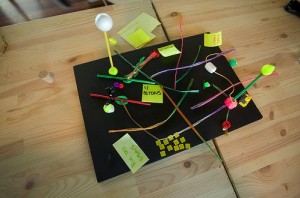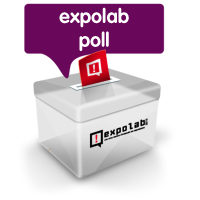The second workshop, “2.0 Projects and practices in cultural institutions” organized by the Centre for Contemporary Culture (CCCB) and Citilab was held on April 28th in the Sala del Mirador at the CCCB. Again, a large number of participants got together to work and define six projects involving the participation of users.
Here are their proposals:
Archiu-us
-
 An area but also a conceptual map for revising the concept of a library.
An area but also a conceptual map for revising the concept of a library. - The user may access the production of the “official” cultural industry in multiple formats.
- Additionally, the user can produce and consume all users’ production.
- It is a structure on the net, where everybody can have access to its content
- The role of the library is to offer tools and facilitate more active roles.
- For example, materials are stored related to personal memory (personal testimonies).
- Seeking to construct a community where the library has an active role in improving its materials.
- As a physical space it has ana are for cataloguing and accessing content and another one for production of content.
- The cataloguing (also participative) would be organized by using an open subject list and keywords.
- A model of copyleft licences for users’ works with different options would be used.
I-lab (laboratory of Ideas)

- A virtual Project open to institutions and individuals for spreading ideas.
- Any institution can take their “needs” to link them and work on them.
- A facilitating area based on tagging ideas.
- It pursues the goal of “democratizing” culture and to collaborate with its environment.
- It would enable ideas and people who are currently disconnected to be grouped together.
- Uusers can bring in projects in which they wish to work.
- Despite being virtual it could also have a physical space or reference.
- It is devised mainly to act only as a connector, with no subsequent follow up of what comes out of it.
“Be the expo”
 Project to make scientific learning more participative, where the user feels part of the process. It offers two possibilities for participation:
Project to make scientific learning more participative, where the user feels part of the process. It offers two possibilities for participation:
- A dynamic process for choosing collectively the subject-areas for the exhibition.
- Concrete Identification of aspects to exhbit in the chosen subject-area.
- In both cases we take a look at what is filtered through the criteria of experts.
- The users are consulted about how the exhibition should be articulated.
- People are invited during the process to learn and be more active in the subject-area under consideration.
- One can interact on-line by modyfing from home the objects and elements exhibited.
- The exhibition can be modified during the participation process.
- Not only do we promote opinion, but we actively modify what happens in terms of personal presence.
- The exhibition is strengthened because it has an online discussion and reflection area outside the reach of the museum or institution that hosts the physicial exhibitions.
- Dynamic processes are promoted to “protagonize” elements of the exhibition (in virical simulations for example).
Traffic

Project to be located in low transing areas: waiting areas, hubs, the global “non-places”.
It developds in three phases:
- Communication with a diverse audience using these “non places”: open questions about what use to give this space are posed there.
- Design of a concrete installation in the space that responds to the requests.
- Celebration of events, actions, exhibitions, concerts, based on the inputs received from users.
Example: the waiting-hall and passageway in Terminal 1 at Barcelona airport
- it is a place where users can decide what is going on in terms of cultural experience.
- The area would be filled with content promoted and generated online or in person.
- The user can add content and suggestions or be just a mere spectator.
- It could, for example, be a platform for emerging creators, who base their ideas around proposals given by users.
- A virtual idea board would be set up to participate from distance or in person, in advance or in situ.
- At an economic level it could be opened to commercial sponsors, or promoted as an opportunity to give added value to the space for the manager of that transit space.
Open door

- Online project facilitating connections between youn creators and promoting them, acting as a launching pad for young creators.
It proposes three lines of action:
- Training: access to knowledge for artistic and cultural creation based on transversal dynamics of sharing between users, on the one hand, and, on the other, by experts in specific aspects that act as consultants for creators.
- Promoting actively the motivation and facilitation of productions. The platform here serves as a channel for networking and distribution of expert advice.
- Publicising the works created via a web presence and networks of contacts that grow around the platform.
- There is also a plan for an functional area for those professionals in charge of run galleries as well as experts so that they can detect talent via access to the platform.
- it will also work as a motivational element with emphasis on learning, on the one hand, and on the other recognition for contributions.
The first kiss
-
 Project based on the possibilities of participation around personal stories about the first kiss
Project based on the possibilities of participation around personal stories about the first kiss - This is used as an example proposal, but it aims in general to the goal of achieving cultural ressonance from projects built around vital experiencies
- It aims to provoke and promote things to happen public areas
- In this case, it could start at the well known “Carrer dels Petons” (Street of Kisses) in the gothic quarter of Barcelona
- It would use a video-photo-booth where people could explain their first love by telling anecdotes about the experience of their first kiss
- People can invited or be invited to enact this first kiss. Also, famous first kisses on history of cinema can be used.
- Street sings would be set up to identify and locate the initiative.
- A webpage would publish the content, and would also be visible from the place where people sign up.
- The project aims to detonate experiences, spark significant action.
- It is open to all ages, as well as in its use to connect with personal stories.
- Project and platform should be designed so that they can be used for other similar experiences.
If you want to see more photos from this event, you will find them in Flickr!
